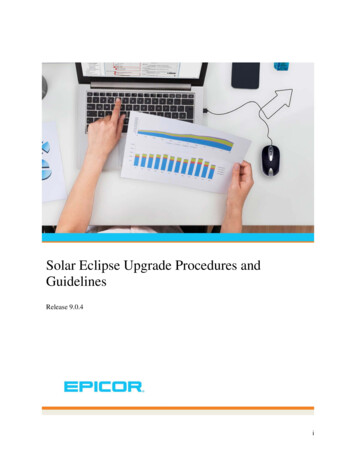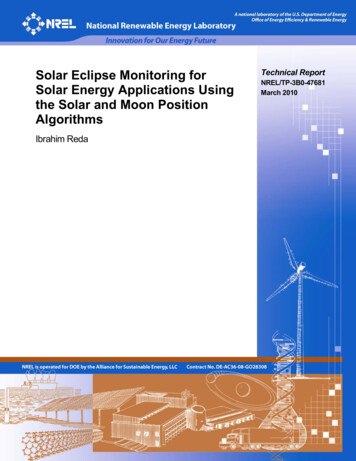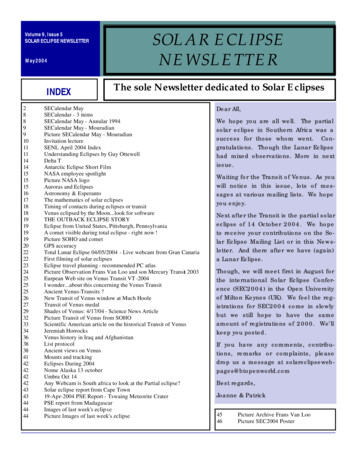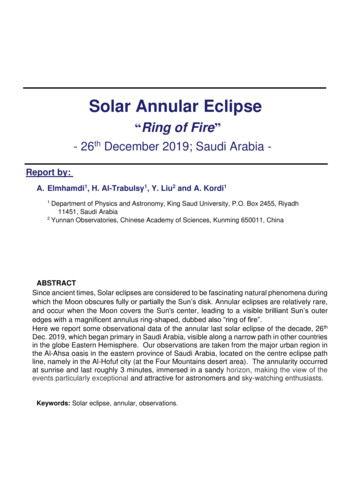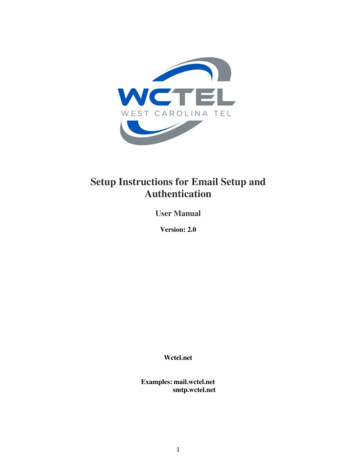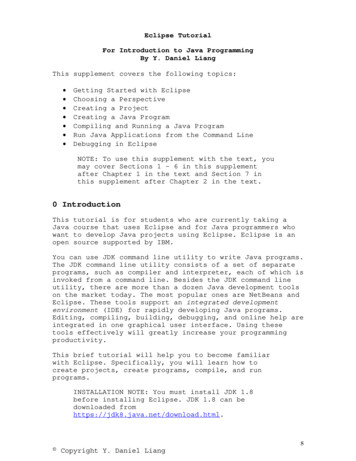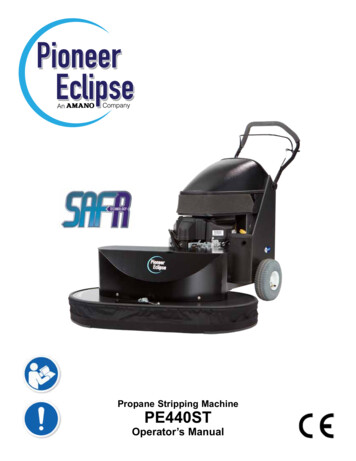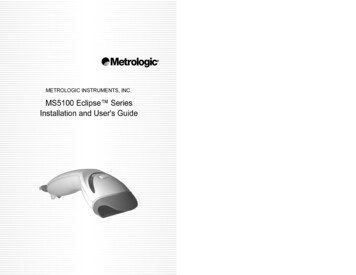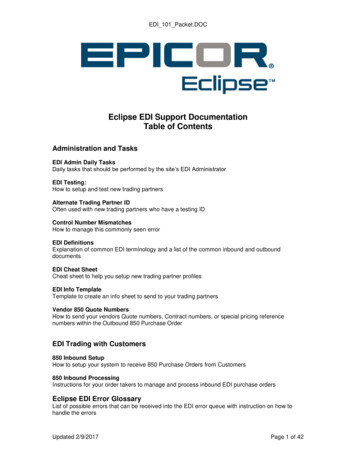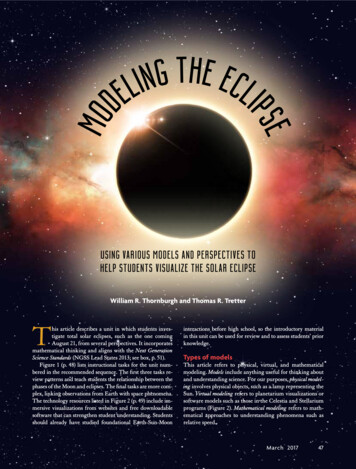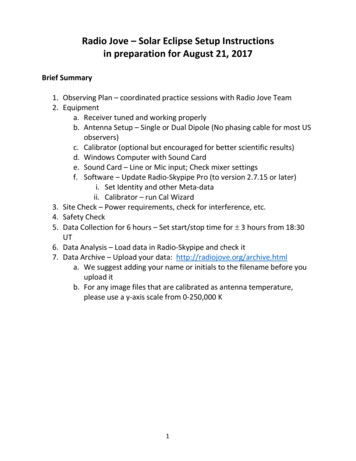
Transcription
Radio Jove – Solar Eclipse Setup Instructionsin preparation for August 21, 2017Brief Summary1. Observing Plan – coordinated practice sessions with Radio Jove Team2. Equipmenta. Receiver tuned and working properlyb. Antenna Setup – Single or Dual Dipole (No phasing cable for most USobservers)c. Calibrator (optional but encouraged for better scientific results)d. Windows Computer with Sound Carde. Sound Card – Line or Mic input; Check mixer settingsf. Software – Update Radio-Skypipe Pro (to version 2.7.15 or later)i. Set Identity and other Meta-dataii. Calibrator – run Cal Wizard3. Site Check – Power requirements, check for interference, etc.4. Safety Check5. Data Collection for 6 hours – Set start/stop time for 3 hours from 18:30UT6. Data Analysis – Load data in Radio-Skypipe and check it7. Data Archive – Upload your data: http://radiojove.org/archive.htmla. We suggest adding your name or initials to the filename before youupload itb. For any image files that are calibrated as antenna temperature,please use a y-axis scale from 0-250,000 K1
Radio Jove – Solar Eclipse Setup Instructionsin preparation for August 21, 2017Introduction. The great American solar eclipse occurs Monday, August 21, 2017. While thenarrow path of totality cuts across the U.S. from Oregon to South Carolina, the entire NorthAmerican continent will be able to see a partial eclipse (Figure 1). Radio Jove observers can joinin a science campaign to help study the Sun, the solar wind, and the Earth’s ionosphere. This isa set of instructions to help you set up your Radio Jove system so we can best compare data.We will make several practice observations over many months prior to the eclipse date so weare adequately prepared. Solar Eclipse oogle2001/SE2017Aug21Tgoogle.html2
Figure 1. This is a western hemisphere map showing the areas of partial and total solar eclipse.Radio observations may be useful from any of the eclipse zones. Image Credit: http://eclipsemaps.com.Single Dipole vs. Dual Dipole Array. A simple, single dipole can be used for adequatelyobserving the Sun. It is more portable if you are setting it up at a temporary location. If youhave a more permanent location, however, the dual dipole array is preferable because it willallow more sensitive monitoring of both Jupiter and the Sun. Its larger size, increasedsensitivity, and ability for phasing, mean better reception of Jupiter and solar bursts. See theRadio Jove antenna construction manual for more pe/equipment manuals.htm.Single Dipole: The preferred setup is an E-W configuration because the dipole is more sensitivein the direction perpendicular to the wire. The eclipse takes place when the Sun is high in thesky (towards the South), so the best orientation of the wire dipole is E-W.Dual Dipole: Again the preferred setup is the dipoles in the E-W direction. Because the Sun willbe high in the sky during the eclipse, we are recommending a zenith-pointing antenna beam(i.e., no phasing cable). See the antenna construction manual for specific details for the antennasetup.Figure 2. Single dipole antenna at a height of 10 feet for the 20.1 MHz Radio Jove receiver. Thefeedline of RG-59 coax should be multiple half-wavelengths in length.3
Site Selection. A temporary setup of a single dipole can be an easy way to test your site. Thereare many sources of interference that can completely mask the signals that you are trying tohear. Power lines can be one of the worst. Others include electric fences, electrical machinery,computers, fluorescent lights. As a general rule it is a good idea to get as far away as possiblefrom power lines or buildings full of computers or electrical machinery. The site can be apermanent site or portable site – if you observe at a portable site, check the site forinterference many weeks or months prior to August 2017.Connecting the Antenna and Receiver. Connect the antenna to the receiver shown in Figure 2.You can listen with an amplified speaker or by the computer speakers.Audio Connections:to speaker, computerComputer runningRadio-Skypipe PowerCalibratorReceiver rear panelFigure 3. Radio Jove receiver setup withcomputer and a 12V battery to powerthe receiver and the calibrator. Anoptional speaker is attached to one ofthe audio jacks. The gray audio cablegoes from the receiver to the computermic or line-in input.Power. The 12V DC power source can be the power supply that came with your Radio Jove kit,a lantern battery (EverReady 732), or a regulated power supply such as the Jameco 162996. Ifyou use battery power, test the battery voltage every few hours to make sure it has not4
dropped below 11 volts. The Jove radio should be turned on for this measurement. It is notrecommended that you use a car battery.Audio Output. Per the antenna construction manual, connect an audio cable from one of theJove receiver audio output jacks to the computer sound card input. Desktop computers haveline and mic inputs while laptops usually have only a mic input. The mic input is often mono andmuch more sensitive, but there can be problems if it competes with a default voice-activatedmic input. If you are using a laptop, check carefully that you are displaying the signal from theradio. The preferred option is the line input which is a stereo input, supporting both left andright channels. Check your computer sound card mixer panel and the Radio-Skypipe softwareunder [Options/Source] for setup options.Receiver Controls. Set your receiver power/volume control to the 12 o’clock position. Adjustyour software volume controls in Windows for a baseline signal around 1000 on SkyPipe withthe antenna connected. You should hear a significant increase in noise level when the antennais connected to the receiver as compared to listening to the receiver with no antenna (Figure 4).Set the Tuning dial on the receiver to a quiet frequency between stations.Figure 4. Typical Radio-Skypipe trace showing effect of connecting and disconnecting antenna.Calibration (optional, but recommended). If you have a calibrator, please connect it as shown inFigure 3. Run the Calibration Wizard on the Radio-Skypipe software to convert your data to anabsolute scale (antenna temperature, kelvins). While the arbitrary scale is perfectly fine, theabsolute scale allows the data to be more scientifically useful. Figure 5 shows some samplesolar bursts with an uncalibrated scale and a calibrated scale. More details on calibration arehere: http://radiojove.gsfc.nasa.gov/telescope/equipment manuals.htm.Computer Timing. Check that your computer clock is accurate. Set your computer clock tomatch a reputable source (i.e., www.time.gov). Accurate timing is essential for data comparisonof solar bursts and other ionospheric phenomena.Use Radio-Skypipe Pro version and Atomic Clock.5
Radio-Skypipe SoftwareThe computer should be running the latest version of Radio-SkyPipe software – get the freeversion here: http://radiosky.com/skypipeishere.html (update to version 2.7.15 via the menuitem Help/Skypipe News after you install the software). Follow the software setup guidelines tomake sure the receiver output is being displayed on the computer. A few key parameters to set:Options/Identity – Complete this to the best of your ability; use the correct time zoneOptions/Strip Chart – Chart Time Format HH:MM:SS [This is the default setting.]Options/Logging – Check the Log Using Universal Time [This is the default setting.]Options/Timing – If possible, check the Auto-start Atomic Clock (Pro Version)Antenna Temperature (kK)Skypipe UnitsExcellent Radio-Skypipe Help: x.html5120256012803200Figure 5. (Top) Uncalibrated chart showing typical solar bursts – each burst usually lasts lessthan a minute. Bursts may come singly or in groups. Usually there is more activity when thereare visible sunspots on the Sun. (Bottom) Similar chart with a calibrated scale in kilo-Kelvin.6
Safety.1. Avoid Lightning (always disconnect the antenna when not in use, and always disconnectthe antenna before a lightning storm is present, and preferably well before the stormarrives.)2. Never assemble the antenna under overhead power lines. The antenna should belocated as far from overhead power lines as is practical.3. Mark your guy ropes with reflective high visibility tapeSolar Eclipse Observations. The full solar eclipse lasts for about 3 hours. Even though totalitymay only be a few minutes, radio observations throughout the entire eclipse may be useful.Even regions of the country outside the path of totality may see changes in the ionosphere, orthey may get lucky and see a solar burst while others may have that solar burst obscured by theMoon. Although a solar radio burst event during the time of a solar eclipse is highly unlikely, wemust be opportunists and be ready. Science thrives on serendipitous discoveries.Also for good scientific reasons, we recommend making observations with the exact samesetup a couple of days before and a couple of days after the eclipse.7
Here is a table of the recommended radio observation times.DatePractice 1Practice 2Practice 3Saturday,August 19,2017Sunday,August 20,2017Monday,August 21,2017Tuesday,August 22,2017Wednesday,August 23,2017Time (UT)PDTMDTCDTEDT15:30 – 21:30 8:30 am –UT2:30 pm9:30 am –3:30 pm10:30 am –4:30 pm11:30 am –5:30 pm15:30 – 21:30 8:30 am –UT2:30 pm9:30 am –3:30 pm10:30 am –4:30 pm11:30 am –5:30 pm15:30 – 21:30 8:30 am –UT2:30 pm9:30 am –3:30 pm10:30 am –4:30 pm11:30 am –5:30 pm15:30 – 21:30 8:30 am –UT2:30 pm9:30 am –3:30 pm10:30 am –4:30 pm11:30 am –5:30 pm15:30 – 21:30 8:30 am –UT2:30 pm9:30 am –3:30 pm10:30 am –4:30 pm11:30 am –5:30 pmArchive Your Data. The Jove team maintains a data archive on the Jove website:http://radiojove.org/archive.html. Please submit your records to this archive so they may beused later for analysis. From the website you can request a password then upload your data perinstructions there.Help or advice. Contact a Jove team member: http://radiojove.gsfc.nasa.gov/contacts.htmSee the hands-on tutorial on the website (although a bit dated, there are many good tips forobserving here): http://radiojove.gsfc.nasa.gov/help/The Radio Jove receiver, antenna, and calibrator manuals have good information about thesetup. You can find them pment manuals.htm8
SAMPLE OBSERVING LOG FORMSName:Observing Partner(s):The source can be Jupiter, the Sun, WWV time signal, or other source. Mark the times when you getinteresting activity along with the appropriate notes on that activity.Observation opTime(local)Source(Sun, Jup,etc.)9Activity Notes (indicate times of solar orJupiter activity, interference, equipmentproblems, etc.)
SAMPLE PLANNING CHECKLIST (before observing day)This is the first checklist, which should be completed by the team leader no later than 1 dayprior to the actual observing day. However, most items on this checklist should be completedfurther in advance as noted to the left of each item. Flags or reflective tape, under equipmentcheckout, should be tied to the cable running from the antenna to the receiver to preventsomeone from tripping.TopicWhen to ObserveSite SelectionTransportationDays BeforeObservation377777Equipment CheckOut1111111Tools1ItemWeather forecastJupiter or solar predictionsWhere to set upSite permissionPower and auxiliary powerVehicle, gas, directionsReceiverBattery and spareSpeakers/headphonesComputer fully-charged batterySoftwareAudio and power cablesAntenna(s) (poles, ropes, stakes, flags orreflective tape)Screwdrivers, hammer, pliers, wrench10Check
SAMPLE OBSERVING DAY CHECKLISTThis is the second checklist, which should be completed prior to leaving to make observations.Remember to give yourself some time in order to set up the equipment and possibly take somegroup pictures. Also remember to bring extra clothing in case the weather turns cool. Adequatelighting, batteries, chairs, and portable tables are important to bring as well.TopicSpare EquipmentGetting ThereSet UpObservationsPacking UpItemAlternate power source(s)Chairs/tablesExtra ClothingLoading equipmentArrive about 1 hour before observationsCheck in with site ownerUnloadingAntenna set upReceiver set upComputer set upGroup picturesTest equipment together (2-3 minutesample observation)Possibly check for WWV signal at 20.0 MHzReceiver tuning (as close to 20.1 MHz aspossible, i.e. about 12 o’clock on the tuningdial)CalibrationSoftwareObserver LogsSite clean up11Check
Solar Eclipse Observations. The full solar eclipse lasts for about 3 hours. Even though totality may only be a few minutes, radio observations throughout the entire eclipse may be useful. Even regions of the country outside the path of totality may see changes in the ionosphere, or they may

